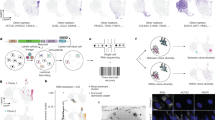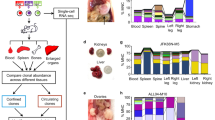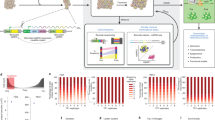Abstract
Resistance to cancer therapies presents a significant clinical challenge. Recent studies have revealed intratumoral heterogeneity as a source of therapeutic resistance. However, it is unclear whether resistance is driven predominantly by pre-existing or de novo alterations, in part because of the resolution limits of next-generation sequencing. To address this, we developed a high-complexity barcode library, ClonTracer, which enables the high-resolution tracking of more than 1 million cancer cells under drug treatment. In two clinically relevant models, ClonTracer studies showed that the majority of resistant clones were part of small, pre-existing subpopulations that selectively escaped under therapeutic challenge. Moreover, the ClonTracer approach enabled quantitative assessment of the ability of combination treatments to suppress resistant clones. These findings suggest that resistant clones are present before treatment, which would make up-front therapeutic combinations that target non-overlapping resistance a preferred approach. Thus, ClonTracer barcoding may be a valuable tool for optimizing therapeutic regimens with the goal of curative combination therapies for cancer.
This is a preview of subscription content, access via your institution
Access options
Subscribe to this journal
Receive 12 print issues and online access
$209.00 per year
only $17.42 per issue
Buy this article
- Purchase on Springer Link
- Instant access to full article PDF
Prices may be subject to local taxes which are calculated during checkout






Similar content being viewed by others
References
Ohashi, K., Maruvka, Y.E., Michor, F. & Pao, W. Epidermal growth factor receptor tyrosine kinase inhibitor-resistant disease. J. Clin. Oncol. 31, 1070–1080 (2013).
Holohan, C., Van Schaeybroeck, S., Longley, D.B. & Johnston, P.G. Cancer drug resistance: an evolving paradigm. Nat. Rev. Cancer 13, 714–726 (2013).
Weisberg, E., Manley, P.W., Cowan-Jacob, S.W., Hochhaus, A. & Griffin, J.D. Second generation inhibitors of BCR-ABL for the treatment of imatinib-resistant chronic myeloid leukaemia. Nat. Rev. Cancer 7, 345–356 (2007).
Gerlinger, M. et al. Intratumor heterogeneity and branched evolution revealed by multiregion sequencing. N. Engl. J. Med. 366, 883–892 (2012).
Morrison, C.D. et al. Whole-genome sequencing identifies genomic heterogeneity at a nucleotide and chromosomal level in bladder cancer. Proc. Natl. Acad. Sci. USA 111, E672–E681 (2014).
Ding, L. et al. Clonal evolution in relapsed acute myeloid leukaemia revealed by whole-genome sequencing. Nature 481, 506–510 (2012).
Diaz, L.A. Jr. et al. The molecular evolution of acquired resistance to targeted EGFR blockade in colorectal cancers. Nature 486, 537–540 (2012).
Turke, A.B. et al. Preexistence and clonal selection of MET amplification in EGFR mutant NSCLC. Cancer Cell 17, 77–88 (2010).
Landau, D.A. et al. Evolution and impact of subclonal mutations in chronic lymphocytic leukemia. Cell 152, 714–726 (2013).
Misale, S. et al. Emergence of KRAS mutations and acquired resistance to anti-EGFR therapy in colorectal cancer. Nature 486, 532–536 (2012).
Robasky, K., Lewis, N.E. & Church, G.M. The role of replicates for error mitigation in next-generation sequencing. Nat. Rev. Genet. 15, 56–62 (2014).
Lu, R., Neff, N.F., Quake, S.R. & Weissman, I.L. Tracking single hematopoietic stem cells in vivo using high-throughput sequencing in conjunction with viral genetic barcoding. Nat. Biotechnol. 29, 928–933 (2011).
Naik, S.H. et al. Diverse and heritable lineage imprinting of early haematopoietic progenitors. Nature 496, 229–232 (2013).
Wu, C. et al. Clonal tracking of rhesus macaque hematopoiesis highlights a distinct lineage origin for natural killer cells. Cell Stem Cell 14, 486–499 (2014).
Lynch, T.J. et al. Activating mutations in the epidermal growth factor receptor underlying responsiveness of non-small-cell lung cancer to gefitinib. N. Engl. J. Med. 350, 2129–2139 (2004).
Paez, J.G. et al. EGFR mutations in lung cancer: correlation with clinical response to gefitinib therapy. Science 304, 1497–1500 (2004).
Pao, W. et al. EGF receptor gene mutations are common in lung cancers from “never smokers” and are associated with sensitivity of tumors to gefitinib and erlotinib. Proc. Natl. Acad. Sci. USA 101, 13306–13311 (2004).
Amann, J. et al. Aberrant epidermal growth factor receptor signaling and enhanced sensitivity to EGFR inhibitors in lung cancer. Cancer Res. 65, 226–235 (2005).
Sharma, S.V. et al. A chromatin-mediated reversible drug-tolerant state in cancer cell subpopulations. Cell 141, 69–80 (2010).
Ohashi, K. et al. Lung cancers with acquired resistance to EGFR inhibitors occasionally harbor BRAF gene mutations but lack mutations in KRAS, NRAS, or MEK1. Proc. Natl. Acad. Sci. USA 109, E2127–E2133 (2012).
Shien, K. et al. Acquired resistance to EGFR inhibitors is associated with a manifestation of stem cell-like properties in cancer cells. Cancer Res. 73, 3051–3061 (2013).
Costa, D.B., Kobayashi, S., Yeo, W.L. & Hamada, A. Serum concentrations of Erlotinib at a dose of 25 mg daily. J. Thorac. Oncol. 5, 1311–1312 (2010).
Bean, J. et al. MET amplification occurs with or without T790M mutations in EGFR mutant lung tumors with acquired resistance to gefitinib or erlotinib. Proc. Natl. Acad. Sci. USA 104, 20932–20937 (2007).
Engelman, J.A. et al. MET amplification leads to gefitinib resistance in lung cancer by activating ERBB3 signaling. Science 316, 1039–1043 (2007).
Sequist, L.V. et al. Genotypic and histological evolution of lung cancers acquiring resistance to EGFR inhibitors. Sci. Transl. Med. 3, 75ra26 (2011).
Ware, K.E. et al. A mechanism of resistance to gefitinib mediated by cellular reprogramming and the acquisition of an FGF2-FGFR1 autocrine growth loop. Oncogenesis 2, e39 (2013).
Byers, L.A. et al. An epithelial-mesenchymal transition gene signature predicts resistance to EGFR and PI3K inhibitors and identifies Axl as a therapeutic target for overcoming EGFR inhibitor resistance. Clin. Cancer Res. 19, 279–290 (2013).
Kubonishi, I. & Miyoshi, I. Establishment of a Ph1 chromosome-positive cell line from chronic myelogenous leukemia in blast crisis. Int. J. Cell Cloning 1, 105–117 (1983).
Soverini, S. et al. BCR-ABL kinase domain mutation analysis in chronic myeloid leukemia patients treated with tyrosine kinase inhibitors: recommendations from an expert panel on behalf of European LeukemiaNet. Blood 118, 1208–1215 (2011).
Soverini, S. et al. Unraveling the complexity of tyrosine kinase inhibitor-resistant populations by ultra-deep sequencing of the BCR-ABL kinase domain. Blood 122, 1634–1648 (2013).
Adrián, F.J. et al. Allosteric inhibitors of Bcr-abl–dependent cell proliferation. Nat. Chem. Biol. 2, 95–102 (2006).
Zhang, J. et al. Targeting Bcr-Abl by combining allosteric with ATP-binding-site inhibitors. Nature 463, 501–506 (2010).
Gorre, M.E. et al. Clinical resistance to STI-571 cancer therapy caused by BCR-ABL gene mutation or amplification. Science 293, 876–880 (2001).
Lange, T. et al. The quantitative level of T315I mutated BCR-ABL predicts for major molecular response to second-line nilotinib or dasatinib treatment in patients with chronic myeloid leukemia. Haematologica 98, 714–717 (2013).
Kunkel, T.A. & Bebenek, K. DNA replication fidelity. Annu. Rev. Biochem. 69, 497–529 (2000).
Robbins, C.M. et al. Copy number and targeted mutational analysis reveals novel somatic events in metastatic prostate tumors. Genome Res. 21, 47–55 (2011).
Tewhey, R. et al. Microdroplet-based PCR enrichment for large-scale targeted sequencing. Nat. Biotechnol. 27, 1025–1031 (2009).
Zhong, Q. et al. Multiplex digital PCR: breaking the one target per color barrier of quantitative PCR. Lab Chip 11, 2167–2174 (2011).
Cerami, E. et al. The cBio cancer genomics portal: an open platform for exploring multidimensional cancer genomics data. Cancer Discov. 2, 401–404 (2012).
Barretina, J. et al. The Cancer Cell Line Encyclopedia enables predictive modelling of anticancer drug sensitivity. Nature 483, 603–607 (2012).
Garnett, M.J. et al. Systematic identification of genomic markers of drug sensitivity in cancer cells. Nature 483, 570–575 (2012).
Gao, J. et al. Integrative analysis of complex cancer genomics and clinical profiles using the cBioPortal. Sci. Signal. 6, pl1 (2013).
Schmitt, M.W. et al. Detection of ultra-rare mutations by next-generation sequencing. Proc. Natl. Acad. Sci. USA 109, 14508–14513 (2012).
Shiroguchi, K., Jia, T.Z., Sims, P.A. & Xie, X.S. Digital RNA sequencing minimizes sequence-dependent bias and amplification noise with optimized single-molecule barcodes. Proc. Natl. Acad. Sci. USA 109, 1347–1352 (2012).
Kinde, I. et al. Evaluation of DNA from the Papanicolaou test to detect ovarian and endometrial cancers. Sci. Transl. Med. 5, 167ra164 (2013).
Kinde, I., Wu, J., Papadopoulos, N., Kinzler, K.W. & Vogelstein, B. Detection and quantification of rare mutations with massively parallel sequencing. Proc. Natl. Acad. Sci. USA 108, 9530–9535 (2011).
Diehl, F. et al. BEAMing: single-molecule PCR on microparticles in water-in-oil emulsions. Nat. Methods 3, 551–559 (2006).
Bozic, I. et al. Evolutionary dynamics of cancer in response to targeted combination therapy. Elife 2, e00747 (2013).
Komarova, N.L. & Wodarz, D. Drug resistance in cancer: principles of emergence and prevention. Proc. Natl. Acad. Sci. USA 102, 9714–9719 (2005).
Iwasa, Y., Michor, F. & Nowak, M.A. Evolutionary dynamics of escape from biomedical intervention. Proc. Biol. Sci. 270, 2573–2578 (2003).
Korpal, M. et al. An F876L mutation in androgen receptor confers genetic and phenotypic resistance to MDV3100 (enzalutamide). Cancer Discov. 3, 1030–1043 (2013).
Rahal, R. et al. Pharmacological and genomic profiling identifies NF-κB-targeted treatment strategies for mantle cell lymphoma. Nat. Med. 20, 87–92 (2014).
Langmead, B. & Salzberg, S.L. Fast gapped-read alignment with Bowtie 2. Nat. Methods 9, 357–359 (2012).
Trapnell, C., Pachter, L. & Salzberg, S.L. TopHat: discovering splice junctions with RNA-Seq. Bioinformatics 25, 1105–1111 (2009).
DePristo, M.A. et al. A framework for variation discovery and genotyping using next-generation DNA sequencing data. Nat. Genet. 43, 491–498 (2011).
Trapnell, C. et al. Transcript assembly and quantification by RNA-seq reveals unannotated transcripts and isoform switching during cell differentiation. Nat. Biotechnol. 28, 511–515 (2010).
Wiederschain, D. et al. Contribution of polycomb homologues Bmi-1 and Mel-18 to medulloblastoma pathogenesis. Mol. Cell. Biol. 27, 4968–4979 (2007).
Acknowledgements
We thank A. Wylie, J. Donovan, S. Zhu, E.R. McDonald, Z. Jagani and B. Firestone for helpful discussion. We also thank J. Brugge, K. Polyak, J. Williams and J. Kuiken for critical reading of the manuscript and K. Yu for technical assistance. R.Z. and F.M. gratefully acknowledge support from the Dana-Farber Cancer Institute Physical Sciences-Oncology Center (U54CA143798).
Author information
Authors and Affiliations
Contributions
H.C.B. and F.S. conceived the project and designed the experiments. H.C.B., D.A.R., J.M.K., M.R.S. and F.S. designed and developed the ClonTracer cellular barcoding system, and H.C.B. constructed the ClonTracer barcode library. H.C.B. and J.X.C. performed the biological experiments and analyzed the data. H.C.B., V.K.R., J.M.K., A.P.S. and D.Y.C. analyzed NGS and RNA-seq data. D.A.R., I.K., D.R., M.M.H., A.R., E.A. and R.J.L. directed or performed NGS and RNA-seq. V.K.R. and J.M.K. performed bioinformatic analysis. R.Z. and F.M. performed mathematical modeling of clonal dynamics. P.S., M.B. and M.P. performed or directed MET copy-number analysis and ABL1 Sequenom mutation analysis. H.C.B., V.K.R., R.Z. and J.M.K. prepared figures and tables. H.C.B., R.Z., W.R.S., F.M., V.G.C., J.M.K. and F.S. wrote and edited the manuscript. W.R.S. and N.K. contributed to oversight of and advice on the overall project. F.S. and J.M.K. provided overall project leadership.
Corresponding author
Ethics declarations
Competing interests
H.C.B., D.A.R., V.K.R., J.X.C., M.M.H., A.P.S., I.K., D.R., P.S., M.B., A.R., E.A., N.K., M.R.S., M.P., R.J.L., D.Y.C., W.R.S., V.G.C., J.M.K. and F.S. are employees of Novartis, Inc., as noted in the affiliations.
Supplementary information
Supplementary Text and Figuress
Supplementary Figures 1–15, Supplementary Tables 1–12, and Supplementary Discussion (PDF 6813 kb)
Supplementary Data Set 1
Mathematical modeling of clonal dynamics in response to ABL1 inhibitor treatment—the distributions of barcode abundance at days 21 and 27. (PDF 952 kb)
Supplementary Data Set 2
Mathematical modeling of clonal dynamics in response to ABL1 inhibitor treatment—the numbers of barcodes with fractions greater than 0.0007 at days 21 and 27. (PDF 201 kb)
Rights and permissions
About this article
Cite this article
Bhang, He., Ruddy, D., Krishnamurthy Radhakrishna, V. et al. Studying clonal dynamics in response to cancer therapy using high-complexity barcoding. Nat Med 21, 440–448 (2015). https://doi.org/10.1038/nm.3841
Received:
Accepted:
Published:
Issue Date:
DOI: https://doi.org/10.1038/nm.3841
This article is cited by
-
Chromosomal barcodes for simultaneous tracking of near-isogenic bacterial strains in plant microbiota
Nature Microbiology (2024)
-
Therapeutic impact of epidermal growth factor receptor tyrosine kinase inhibitor with various treatment combinations for advanced lung adenocarcinoma
World Journal of Surgical Oncology (2023)
-
Clonal heterogeneity in ER+ breast cancer reveals the proteasome and PKC as potential therapeutic targets
npj Breast Cancer (2023)
-
Disrupting cellular memory to overcome drug resistance
Nature Communications (2023)
-
Proteomic time course of breast cancer cells highlights enhanced sensitivity to Stat3 and Src inhibitors prior to endocrine resistance development
Cancer Gene Therapy (2023)



